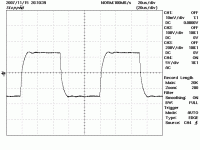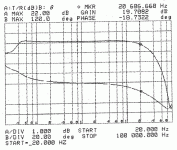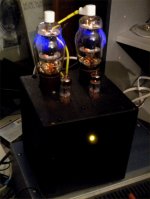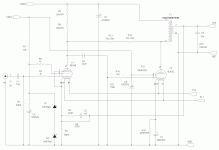I'm getting ready to open up the amp and do some modifications to increase the output stage quiescent current. Is there a diy type in the SF Bay area who has some high efficiency speakers and wouldn't mind a visitor? I'd like to audition the amp on appropriate speakers before I go to the next stage of ditching the global feedback and bypass caps on input and output stages and trying cathode feedback a la George...
I'm still kicking myself for not hooking this amp up to the Metronome speakers at Burning Amp.
I'm still kicking myself for not hooking this amp up to the Metronome speakers at Burning Amp.
I took the amp apart and revamped my power supply with the zener clamp network as described a couple of posts earlier to protect against B+ overshoot - worked like a charm. The B+ now rises no higher than 370V (instead of 470V), and settles back down to 350 once the filaments heat up. This takes longer now, as the filament voltage is depressed by the clamp network until everything settles down. No thermal shock for those filaments....
I also reduced the cathode resistor s on the 1625s from 600 ohms to 400 ohms. This raised the output stage quiescent current to 60mA from 50mA. Nothing glowing so far except for the cathodes. Next up is some frequency response and square wave testing.
I also reduced the cathode resistor s on the 1625s from 600 ohms to 400 ohms. This raised the output stage quiescent current to 60mA from 50mA. Nothing glowing so far except for the cathodes. Next up is some frequency response and square wave testing.
Here is the frequency response with 10 ohms load and ~100mV excitation. I wanted to use enough excitation for 1W RMS output, but it overloads the inputs of the HP4194A gain-phase analyzer I'm using.
I took the amp home and hooked it up to my living room speakers, whch are hexagonal prisms loaded with (16) 4.5 inch Parts Express/Vifa drivers and (3) Vifa soft dome tweeters each. The speakers are 4 ohms, so the amp can deliver only about 4 W a side. It sounded ok, but no magic. Clearly, I'm going to need some more sensitive speakers to allow the amp to strut whatever stuff it has.... One small bonus - in my dim living room, I was able to see some cathode ray fluorescence on the 1625 envelopes, which danced around in time the music. There wasn't much, as the 1625 plates are pretty much closed cylinders.
I took the amp home and hooked it up to my living room speakers, whch are hexagonal prisms loaded with (16) 4.5 inch Parts Express/Vifa drivers and (3) Vifa soft dome tweeters each. The speakers are 4 ohms, so the amp can deliver only about 4 W a side. It sounded ok, but no magic. Clearly, I'm going to need some more sensitive speakers to allow the amp to strut whatever stuff it has.... One small bonus - in my dim living room, I was able to see some cathode ray fluorescence on the 1625 envelopes, which danced around in time the music. There wasn't much, as the 1625 plates are pretty much closed cylinders.
Attachments
Well, I've been sitting around looking at this amp in my living room for a month and a half, and have been working instead with a fairly newly minted JFET/MOSFET amp. Last night, I hooked up the Shrine again and took it out for a stroll with a copy of "Harry Potter and the Order of the Phoenix" (nicely done score). Same 4 ohm speakers and everything.
I must have been tired and out of sorts listening last time around, because I'm really liking this amp now. Volume is not so hot because of the non-optimal output load, but detail rendering and imaging is excellent. I also tried it with a variety of analog and digital sources after the movie, with the same level of satisfaction. The only caveat is that electronic music/techno with very deep synthesized bass will quickly reveal the limitations of the tiny Edcor output transformers. I've been in touch with Transcendar, and they will add a 50% ultralinear tap to their small 10W output transfomers for a nominal fee. These are wound on a big stack of EI100s rather than the EI75s used by the Edcors, so bass extension would be a lot better.
Of course, this is also going to inspire me to get a move on making some more efficient speakers. I think I'm in love.... Right now the amp is doing a nice job with an old Columbia recording of David Oistrakh violin masterworks.
I must have been tired and out of sorts listening last time around, because I'm really liking this amp now. Volume is not so hot because of the non-optimal output load, but detail rendering and imaging is excellent. I also tried it with a variety of analog and digital sources after the movie, with the same level of satisfaction. The only caveat is that electronic music/techno with very deep synthesized bass will quickly reveal the limitations of the tiny Edcor output transformers. I've been in touch with Transcendar, and they will add a 50% ultralinear tap to their small 10W output transfomers for a nominal fee. These are wound on a big stack of EI100s rather than the EI75s used by the Edcors, so bass extension would be a lot better.
Of course, this is also going to inspire me to get a move on making some more efficient speakers. I think I'm in love.... Right now the amp is doing a nice job with an old Columbia recording of David Oistrakh violin masterworks.
The Shrine has been reliably doing duty in my living room for quite some time now, and is more satisfying than any solid state amp I currently own. Only two complaints - low volume (it's driving 4 ohm speakers, though), and lack of bass extension. I was thinking of replacing the tiny Edcor output transformers with baby Transcendar 5k units with custom UL taps, but even the baby Transcendar transformers are too big to fit inside the 6" cube chassis I'm using. However, Edcor has augmented their series of budget SE transformes with a line of slightly more expensive units with better bass extension. They use the same mounting centers as the original XSE series, but have a bigger stack of lams, making them somewhat thicker than the one's I'm currently using. It looks like they'll fit inside the case, though.
I think it's time I gave my little amp a birthday present... If the new transformers pep it up, I may bring my little friend back to Burning Amp with me this year.
I think it's time I gave my little amp a birthday present... If the new transformers pep it up, I may bring my little friend back to Burning Amp with me this year.
Well, this amp got refitted with Edcor GSXE-15-8-5k transformers (larger than the original XSE-15-8-5k available when I first built this amp) for more low end extension without saturation. I also changed the feedback resistors to 1.4k to increase the gain a bit and remove the little bit of square wave overshoot shown a few posts ago. I also changed the tube caps and wires (NOS National tube caps vs. the Chinese junk that doesn't grip after one on/off cycle), and changed to a old-school yellow LED indicator (much easier on the eyes than the hyper-bright blue LED it replaced). I was afraid of screwing up the amp as it had served as my standard living room workhorse for the better part of a year, but it survived all the mucking about.
This amp will be travelling to Burning Amp with me and doing a David vs, Goliath comparison with some larger brethern with linear power supplies. It should be interesting.
I've been messing about a bit with pentodes as pentodes instead of triode connecting them (check the 6CD6GA enhanced triode thread), and have come to the concluson that this amp might have fared pretty well if I had used the 6AH6 originally envisioned for the input stage as a real pentode instead of triode connected. I may try that in another version of this circuit, as I have a 6" cube LMB utility box floating around looking for a purpose in life, and some Svetlana 6L6GCs also looking for a steady job. It could be a partless wonder...
This amp will be travelling to Burning Amp with me and doing a David vs, Goliath comparison with some larger brethern with linear power supplies. It should be interesting.
I've been messing about a bit with pentodes as pentodes instead of triode connecting them (check the 6CD6GA enhanced triode thread), and have come to the concluson that this amp might have fared pretty well if I had used the 6AH6 originally envisioned for the input stage as a real pentode instead of triode connected. I may try that in another version of this circuit, as I have a 6" cube LMB utility box floating around looking for a purpose in life, and some Svetlana 6L6GCs also looking for a steady job. It could be a partless wonder...
This amp has served in my living room for the better part of 2 years, but now I'm getting the itch to change things a bit. I want to do a partial feedback amp and have several options open - 1) Keep the cascoded jfet front end and connect things up for partial feedback Schade-style with the 1625 outputs in full beam tetrode glory 2) Ditch the hybrid front end for a 7-pin pentode (6AH6 and 6EW6 are obvious choices) with Schade-style feedback. 3) Go e-linear (the output XFMR has a screen tap) with either option 1) or 2). Whichever option I choose will involve a little global feedback to straighten out the output transformers, which are the Edcor GXSE series 5k. These won't change, as they are the most ambitious transformers that will fit inside the case. If I do move things around, the amp will make another trip to BA - It didn't do too badly in 2009 in its original UL configuration. Full beam tetrode mode with partial feedback should endow it with larger cojones...
This silly little amp is getting retrofitted as a partial feedback amp with pentode input and output. The output tubes will still be the venerable (and cheap) 1625. The input tubes are changed to the 6EW6. Retrofit is about 75% complete, and schematic will follow when I'm sure it's working rignt. The overall look of the amp will be almost unchanged, except that I got rid of the cheap 7-pin phenolic sockets I first used for the input tubes and replaced them with Russian ceramic sockets that have nice silver-plated contacts and a retainer.
This silly little amp is getting retrofitted as a partial feedback amp with pentode input and output. The output tubes will still be the venerable (and cheap) 1625. The input tubes are changed to the 6EW6. Retrofit is about 75% complete, and schematic will follow when I'm sure it's working rignt. The overall look of the amp will be almost unchanged, except that I got rid of the cheap 7-pin phenolic sockets I first used for the input tubes and replaced them with Russian ceramic sockets that have nice silver-plated contacts and a retainer.
Nice find for the driver tube.I have used the 6AU6 but the 6EW6 looks much beefier and with very high transconductance.
Good luck on the build.
Shoog
I went ahead and did a layout for a version of this amp using 6EW6 input stage and 6L6GC outputs, with partial feedback. I plan a build that will look a lot less utilitarian, scavenging the output transformers ans SMPS from the first incarnation. Still a compact amp, but kinda long and slender. I'll be combining oak and aluminum (maybe with black crackle finish).
I've recently played around with a very similar tube combo (6384 and 6EW6) and an Edcor output transformer.
I didn't take any feedback around the transformer, but I did take feedback from output tube plate to input tube cathode. I just took the approach of getting a bunch of gain from the 6EW6 and putting it into the one loop for feedback. I loaded the 6EW6 with a CCS||1M and added a p-channel fet to drive the cathode of the 6EW6, with the gate tied to the feedback divider point. This got the gain of the input stage up over 2000.
This worked really well and got distortion down to 0.046% @ 1W with second harmonic dominant, and only 2nd and 3rd detectable. Clipping happened at about 10W. Zout was 0.6 Ohms, the vast majority of that being winding resistances.
Anyway, I love the 6EW6 (I bough a stockpile of the dual version, the 6BN11). It's got a lot to offer.
I've always wanted to use a switcher for B+, but lack the knowledge to make one myself. I can't wait to see more of how this turns out.
I didn't take any feedback around the transformer, but I did take feedback from output tube plate to input tube cathode. I just took the approach of getting a bunch of gain from the 6EW6 and putting it into the one loop for feedback. I loaded the 6EW6 with a CCS||1M and added a p-channel fet to drive the cathode of the 6EW6, with the gate tied to the feedback divider point. This got the gain of the input stage up over 2000.
This worked really well and got distortion down to 0.046% @ 1W with second harmonic dominant, and only 2nd and 3rd detectable. Clipping happened at about 10W. Zout was 0.6 Ohms, the vast majority of that being winding resistances.
Anyway, I love the 6EW6 (I bough a stockpile of the dual version, the 6BN11). It's got a lot to offer.
I've always wanted to use a switcher for B+, but lack the knowledge to make one myself. I can't wait to see more of how this turns out.
Here's the schematic for one channel, with preliminary values. I'll be getting the boards at the end of the week.
So I'm guessing this schem. is basically the same for the 1625 as well?
jeff
Since this old thread has been re-activated:
1625 25 Watt plate
350V 3.5 Watt screen (807 says 400V for triode wired)
6L6GC 30 Watt plate
450V 5 Watt screen
6L6GC has more flexibility for both UL and Triode wired modes, versus the 1625 / 807.
The 6L6GC is still being manufactured, I am not sure about the 1625 / 807.
1625 25 Watt plate
350V 3.5 Watt screen (807 says 400V for triode wired)
6L6GC 30 Watt plate
450V 5 Watt screen
6L6GC has more flexibility for both UL and Triode wired modes, versus the 1625 / 807.
The 6L6GC is still being manufactured, I am not sure about the 1625 / 807.
Last edited:
I may try bodging in a current source load on the input pentode, normally a bad idea (dueling current sources - duh duh duh duh dunn..). However, the extra load of the partial feedback resistor will likely make it possible. I'll try running it using the original schematic first, though.
- Status
- This old topic is closed. If you want to reopen this topic, contact a moderator using the "Report Post" button.
- Home
- Amplifiers
- Tubes / Valves
- "Shrine" SE Amp using 6AH6 and 1625



